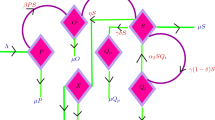Abstract
In this paper,the dynamics of smoking behavior under the influence of educational and media programs is modeled in the presence of two control strategies. Optimal control theory is applied to a non-linear mathematical model on smoking: impact of anti-smoking campaign which helps in obtaining time dependent case detection strategy while minimizing the cost of implementation of such strategy. We prove the existence of an optimal control set and analyze the necessary and sufficient conditions, optimality and transversality conditions. The optimality of the system is deduced analytically and solved numerically.









Similar content being viewed by others
References
Ahmad A, Farman M, Ahmad MO, Raza N, Abdullah (2018) Dynamical behavior of SIR epidemic model with non-integer time fractional derivatives: a mathematical analysis. Int J Adv Appl Sci 5(1):123–129
Ahmad A, Farman M, Yasin F, Ahmad MO (2020) Dynamical transmission and effect of smoking in society. Int J Adv Appl Sci 5(2):71–75
Arafa AAM, Rida SZ, Khalil M (2012) Fractional modeling dynamics of HIV and 4 T-cells during primary infection. Nonlinear Biomed Phys 6:1–7
Ashraf F, Ahmad A, Saleem MU, Farman M, Ahmad MO (2018) Dynamical behavior of HIV immunology model with non-integer time fractional derivatives. Int J Adv Appl Sci 5(3):39–45
Biazar J (2006) Solution of the epidemic model by Adomian decomposition method. Appl Math Comput 173:1101–1106
Bonyah E, Khan MA, Okosun KO, Islam S (2017) A theoretical model for Zika virus transmission. PLoS One 12(10):1–26
Buonomo B, Lacitignola D (2008) On the dynamics of an SEIR epidemic model with a convex incidence rate. Ricerche Mat 57:261–281
Busenberg S, Driessche P (1990) Analysis of a disease transmission model in a population with varying size. J Math Biol 28:65–82
Castilho C (2006) Optimal control of an epidemic through educational campaigns. Electron J Differ Eq:1–11
El-Sayed AMA, Rida SZ, Arafa AAM (2009) On the solutions of time-fractional bacterial chemotaxis in a diffusion gradient chamber. Int J Nonlinear Sci 7:485–495
Fleming wendell H, Rishel Raymond W (1975) Deterministics and Stochastic Optimal Control, vol 1. Springer Verlag, New York
Fister KR, Lenhart S, McNally JS (1998) Optimzing chemothearpy in an HIV model. Electron J Diff Eq:1–12
Garsow C Castillo, Jordan-Salivia G, Rodriguez Herrera A (1997) Mathematical models for the dynamics of tobacco use recovery and relapse Technical Report Series BU-1505- M: Cornell University Ithaca NY USA
Haq F, Shah K, Rahman GU, Shahzad M (2018) Numerical solution of fractional order smoking model via laplace Adomian decomposition method. Alex Eng J 57:1061–1069
https://en.wikipedia.org/wiki/Epidemiology. 17th Nov 2016
Kar TK, Jana S (2013) A theoretical study on mathematical modeling of an infectious disease with application of optimal control. BioSystems 111:37–50
Kribs-Zaleta CM (1999) Structured models for heterosexual disease transmission. Math Biosci 160:83–108
Kusum Lata, Mishra SN, Mishra AK (2020) An optimal control problem for carrier dependent disease. BioSystems 187:1–10
Lenhart S, Workman J (2007) Optimal Control Applied to Biological Model. Chapman and Hall/CRC,
Liu X, Wang C (2010) Bifurcation of a predator-prey model with disease in the prey. Nonlinear Dyn 62:841–850
Lukes DL (1982) Differential equations: classical to controlled. Acad Press NY 162:182
Matintu SA (2017) Smoking as epedemic modeling and simulation study. Am J Appl Math 5:31–38
Misra AK, Sharama A, Shukla JB (2011) Modeling and analysis of effect of awareness programs by media on the spread of infectious diseases. Math Comput Model 53:1221–1228
Misra AK, Sharma A (2014) Modeling the impact of awareness created by media campaigns on vaccination coverage in a variable population. J Biol Sys 22:249–270
Misra AK, Sharama A, Singh V (2011) Effect of awareness programs in controlling the prevalence of an epidemic with time delay. J Biol Sys 19:389–402
Misra AK, Sharma A, Shukla JB (2015) Stability analysis and optimal control of an epidemic model with awareness programs by media. BioSystems 138:53–62
Njankou SDD, Nyabadza F (2016) An optimal control for Ebola virus disease. J Biol Sys 24(1):1–21
Algahtani Obaid J, Momani Anwar Zeb Gul Zaman Shahar, Jung IH (2015) Mathematical study of smoking model by incorporating campaign class. Department of Mathematics King Saud University, Saud Arabia
Okosun KO, Makinde OD (2014) A co-infection model of malaria and cholera diseases with optimal control. Math Biosci 258:19–32
Okosun KO, Khan MA, Bonyah E, Ogunlade ST (2017) On the dynamics of HIV-AIDS and cryptosporidiosis. Eur Phys J Plus 132(8):363
Pontryagin LS, Boltyanskii VG, Gamkrelidze RV, Mishchenko EF (1962) The mathematical theory of optimal process. Interscience Publishers, New York
Sharomi O, Gumel AB (2008) Curtailing smoking dynamics a mathematical modeling approach. Appl Math Comput 195:475–499
Shukla JB, Ram Naresh, Rani Verma Sandhya, Manju Agarwal (2020) Modeling the effect of sanitation in a human habitat to control the spread of bacterial diseases. Model Earth Syst Environ 6(1):39–49
Shyam Sundar, Kumar Mishra Ashish, Ram Naresh (2018) Modeling the impact of media awareness programs on mitigation of carbon dioxide emitted from automobiles. Model Earth Syst Environ 4:349–357
Verma V, Bhadauria Archana S (2019) Global dynamics of a mathematical model on smoking:impact of anti-smoking campaign. J Math Model 7(1):49–62
World Health Organization report on tobacco (2013) http://www.who.int/tobacco/globalreport/2013/en/index.html
Zaman G (2011) Qualitative behavior of giving up smoking model. Bull Malaysian Math Sci Soc. 2:403–415
Acknowledgements
The authors thank the handling editor and anonymous referees for their valuable comments and suggestions which led to an improvement of our original manuscript.
Author information
Authors and Affiliations
Corresponding author
Additional information
Publisher's Note
Springer Nature remains neutral with regard to jurisdictional claims in published maps and institutional affiliations.
Rights and permissions
About this article
Cite this article
Verma, V. Optimal control analysis of a mathematical model on smoking. Model. Earth Syst. Environ. 6, 2535–2542 (2020). https://doi.org/10.1007/s40808-020-00847-1
Received:
Accepted:
Published:
Issue Date:
DOI: https://doi.org/10.1007/s40808-020-00847-1




